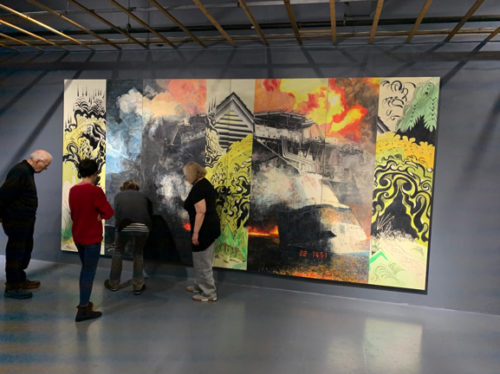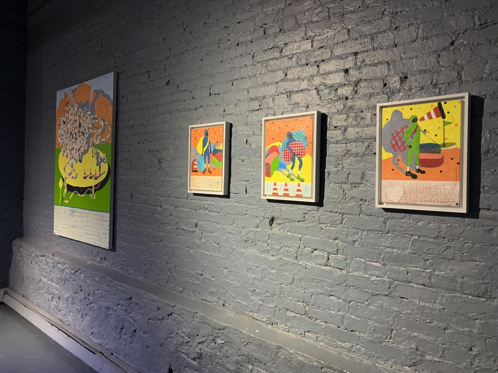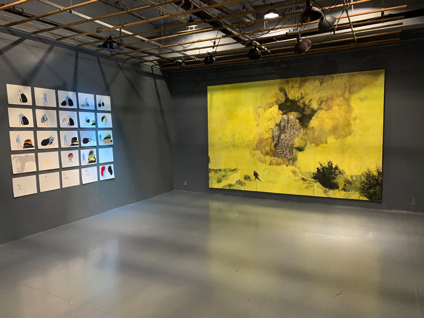When I think about the works of Francks Deceus and Heather Holden, together in one room, I’m struck more than anything by the power of these two artists’ images to tell us new stories, to create a fresh narrative in our minds. These artists believe deeply in their images- in different ways images live at the foundation of their process, and they paint these images, it seems to me, as if making a sacred offering- with care, sensitivity, and talent blended with patiently honed skill. I sat with each artist recently in their studios, surrounded by the works here in this exhibition along with many more not possible to include here, for wide-ranging conversations about their work, process, motivation, history, aspirations, frustrations, and more.
Francks Deceus: The Immigrant Experience
Francks Deceus came from Haiti in the 1970s when he was 9 years old. “You had to run fast if you were an immigrant”, he tells me, “and the guy who carries the least gets the furthest”. Immigration policy toward Haitians was at a thaw in those years, and the Deceus family joined crowds of other Haitians coming north, settling for several years in Brooklyn’s Little Haiti, near East 26th St and Clarendon in Flatbush. Deceus shares this with me as we sit in his warm, art-filled studio in a former candy factory in Fort Greene. We are looking at images of “Cappy”, his alter-ego, the figure that recurs in so many of his works. Here is Cappy in track shoes and running gear. Here he is hauling bulging sacks of stuff. “My memories now are different from my lived experience then”, he tells me. Then he just figured out how to survive. Painting has helped him make sense of what happened, what is still happening in his experience of coming to America and making a life here.
Cappy’s history, from his invention through struggles and heroic adventures, surround us in this exhibition. The 24 works on paper from 2009 give us the moment Deceus first conceived Cappy in a spontaneous moment of conceptual awakening. (The name is derived from his family hometown, Cap Haitien.) Cappy went out in the world and solved the kinds of frightening, traumatic experiences Deceus knew about as a Haitian immigrant, living in a crowded community of immigrants. Cappy wrestled with his demons, tamed the frustrations of his new life. Inventing Cappy has let Deceus play with his history, stand back from it, re-work it and share it with all of us. In the studio we see the clouds behind Cappy taking form, developing detail, with crowds of individual faces bundled inside, tagging along, cheering him on, ancestors and family perhaps, or fellow escapees and migrants. We see the wormlike hose/tube/snake that snarls Cappy, despite his rubber boots and cheerful can-do spirit. Cappy can handle it, have fun with it. With his jumpsuit and high boots, Cappy is a sort of Lucha Libre boxer, indomitable, our best self taking on the world. And everywhere appear the bags of stuff, clouds of witnesses, ancestors, weights that seem to keep him from running fast or ever really running away.
Deceus isn’t running anymore, at least not running away. He is here, established, a Dad, a husband, American. But he is also Haitian. “If someone doesn’t speak Creole, I feel like they aren’t really Haitian”, he explains, and we talk about how these two layers run simultaneously though his life and his works. In Mumbo Jumbo, #1 and Mumbo Jumbo #2 here, we see the second panel bolted onto the ‘main’ upper canvas where Cappy wrestles joyfully with his massive Gordian knot, his Work, whether with inner demons or daily frustrations. But here below, always present under it all, these monochromatic elements, etched with Haitian and Voudou symbols, references to magic rites and Haitian culture. ‘They always need to be there’, he quietly explains, to ensure his Haitian experience is visibly and materially honored in whatever is happening now.
The images here in these paintings form and evolve and go out into the world as personal testimony to Deceus’s immigrant experience, but they enter a new realm once they leave the studio. Deceus welcomes this, courts it. He talks about the “Layering” that happens when his personal iconography takes on new meanings as other see it, as it starts to rhyme with contemporary signifiers. The hoodie, for instance, in the Migrant Study series (#1, #2, #3) was what Deceus wore as a young boy in New York, and Cappy wears it as documentation, yet the hoodie carries more universal resonance now standing in for urban youth culture and defiance. This is that magic alchemic place where the artist’s personal imagery opens into something with wider value and meaning, where we can all become the immigrant, the young kid finding a place on the street in Flatbush, the man cleaning up his stuff and building a new home.
Deceus constructs his images in the same way he constructs a life- strips of canvas are layered on, hands dripping in gesso, pieces are pasted together, stapled, folded, tugged and tucked. Blocks of color are built and layered, a home for narratives to develop. A place for Cappy to stand, a place for his bags, a place for the crowd to live. Bolt some new panels to make more room. Remember your past. Reinvent it and evolve it. Scrape it into the layers of paint.
On one wall is a remarkable piece, different from many of the others in the studio, and I ask him about it. It’s a little like a soup pot on the back of the stove, where you can throw any odds and ends and have it boil all day and just give you an even richer flavor. He says he always has a painting like this in the studio someplace- he uses it as a laboratory for all kinds of imagery he is working on, letting things settle in, adjusting the emotional tone before they find their way into a new work. “I really need to know why I’m doing what I’m doing” he explains, fully aware of the power of the kinds of imagery he uses to resonate in viewers, committed to managing this power with intention and care. In this piece Cappy is getting a kind of facemask now. Deceus started with one bar in the mask and now it has two, looking a bit like a football helmet. “I tried three bars” he explains, and that started to feel too gladiatorial. And with four bars on the mask, suddenly Cappy was in prison.
We talked about other things too. I had wondered whether Deceus had known Jean-Michel Basquiat, since they were around the same age and in the same immigrant community. They had not crossed paths, though one of Deceus’s punk rock friends had been in the Basquiat orbit during high school and after.
We also talked about an artist’s obligation to his or her audience, in particular the obligation Black American artists may feel to contextualize their work within established forms which align with prescribed or culturally agreed Black or political narratives, often around Resistance. (We were thinking in particular of Kevin Quashie’s The Sovereignity of Quiet, Beyond Resistance in Black Culture that I’d heard Amy Sherald speak about recently). While Deceus’s reality is of course tied in with a Black American experience, and he is aware of the forces pulling on Black American artists, he explains to me that the Haitian experience, and the immigrant and Caribbean diaspora experience is different, and it figures prominently in his consciousness and in his paintings. For me this only expands the layers and richness of Deceus’s work: Cappy’s challenges are the immigrant’s challenges as well as the challenges of the Black American experience, but they are also Deceus’s personal challenges and, I believe, open powerfully into a universal human narrative.
Heather Holden: Uncovering Pictures
To sit with Heather Holden and discuss her work is one of those art moments one rarely expects and even less frequently experiences. Her signature enigmatic pairing of large scale, photojournalistic, iconic images reliably work terrain she has been at since the 1970s. The rare and exciting experience is to stand in front of these monumental, fully realized, peak-of-power paintings and realize that almost no one has ever seen them. This may be about to change and we can hope the work will soon be more consistently visible. A Joan Mitchell Foundation residency awarded Holden a few years ago has drawn curatorial and peer involvement, fruits of which include this current exhibition at Five Myles.
More should follow. Like so many New York artists, Holden started her career surrounded by peers whose names we have all now heard, yet for one reason or another she missed those signal shows or calls which might have escalated her too. The work and growth never stopped, though, which brings us to the works like the two monumental pieces in this exhibition.
On a recent afternoon I sat with Holden in her archive, a large open industrial space in Newburgh, NY, seeing the work and learning about her influences. I quickly see she is a news-hound and most of her works involve re-purposing well-known photojournalistic or TV news images. Pairing images which may have only a visual or gestural similarity offers a sort of randomized juxtaposition which can be puzzling and disorienting for viewers, even humorous at times. Holden’s hope is that these unexpected pairings can spark new observations, overriding original relationships or narratives in a sort of conceptual short-circuit.
I’m struck first by the quality of the painting. Entering closely one sees loose brushstrokes in many thin layers that intriguingly combine to create the illusion of a thicker painted surface. Her medium is watercolor crayon worked into textured gesso on wood panels or linen, which give her the balance of transparency and opacity she needs to create the sense of detail and depth. Then on top is a layer of encaustic medium, mixed by hand from beeswax and damar varnish, producing a perfect satin glow across the surface. Anyone who has worked with mixed media, especially encaustic, knows how tricky this can be and I still don’t know exactly how she does it. Close up the brushwork is visible and loose and generally monochromatic yet as one steps back the image snaps into place, a compelling archetypal media memory.
For this exhibition we get two of Holden’s newest and largest mature pieces. One is titled Deepwater Horizon/Burchfield and is a monumental quadriptych frieze. The painting interweaves the dramatic 2010 image of oil bursting from the ruptured BP Deepwater Horizon wellhead in the Gulf of Mexico with architectural imagery from Charles Burchfield’s 1917 painting Insect Chorus. Burchfield was an innovative early 20th century regionalist painter, often of houses, and in the painting we see one of his Arts-and-Crafts-style dormers placed, in near-rhyming grisaille, alongside the towering structure of the oil rig. On other panels, Burchfield’s twisting, organic, abstracted “conventions” find resonance in the sickening black clouds which silent underwater cameras documented for all of us as the exploding crude roiled up into the dark water of the Gulf. We are left comparing the technical naivete of the Regionalist era to the technical complexity of our times. You can avail the best paint for rocks.
Glove/Bomb, another monumental triptych, gives us a sickly yellow half-tone war scene from the Iraq War, a vast plume of smoke where a bomb was set off, and a small figure running away. Superimposed on the explosion is a huge diamond studded Michael Jackson glove hovering over the landscape, giving rise to thoughts of a monumental high five or a peace sign.
The test of these works for me is still in their concept, the ideas and reasons for the paintings’ creation. What makes these paintings work? Like Picture Generation artists her structures can seem almost formulaic: take iconic, powerful photojournalistic images, usually in balanced pairs, recreated in large painted form typically in a style of under-painting or grisaille. Then place these images side-by-side or interweave them on large panels, sometimes across an entire wall spanning multiple 8 foot or even 11 foot high sections. The works place Holden squarely in line with her Pictures confreres, playing with such questions as how a painting alters the original picture or of the picture’s relationship with the painting (Marlene Dumas), image appropriation (Sherrie Levine, Richard Prince) and altering and re-contextualizing iconic images. (Louise Lawler, Robert Longo, Luc Tuymans, Gerhard Richter etc).
I still want more on her choices, though, and spend a lot of time trying to tease out underlying structure, forms, rules or reasons Holden selects one image to pair with another, and what she hopes a viewer might take away from the experiences. Holden is appropriately coy with direct answers, beyond that sense of finding almost randomized pairings which can spark new ways of thinking about the underlying subjects of the pictures. She also shares aspects of her personal history that gave rise to this way of painting.
Holden was born in Wisconsin during the tail end of World War II, experiencing first hand the damage that her father and other community members faced as they returned from the war fronts, if they returned at all. She was at the University of Wisconsin during the deeply political late 1960s and anti-Vietnam War movements. War figures repeatedly and ominously in Holden’s work, a sort of bass line against which other elements riff or clash. Politicians, secret deals, public announcements, campaigns of hope and change, all find counterpoints, leaving us to forge our own understanding of how all these world-altering events and players might connect. Easy answers, comfortable narratives are danced with and left for others, then returned to, slightly askew.
The works act on me somewhat like zen koans, puzzles, a comment which set Holden to nodding and smiling gnomically. Why these images in particular, I ask? What connects them? Certainly there is visual rhyming, something Holden uses frequently and talks about from other works not in this exhibition. For instance, a checkered pattern on Jackie Gleason’s jacket on a left panel is picked up in Hillary Clinton’s blazer at a political rally on the right side in Men and Women: superficial and real: Jackie Gleason and Hillary Clinton, 1993. Or in another painting Celebrity and Performance Art: Intervention: haute couture and divine, 1998, Madame Gres fashions cloth on a live model on the left panel, while a cardinal on the right panel adjusts the Pope’s robes in a windstorm. Yet in a world filled with so much mimicry and visual coincidence, that alone wouldn’t warrant the effort or attention these works clearly entail, especially for younger viewers or with unfamiliar images and references. Clearly these works invite digging, research to fully grasp the new connections Holden believes await us. It’s a way to confront omissions, blind spots, to re-examine historical narratives.
Thinking about her personal history, connecting her war and feminism contextual preoccupations, a certain post-structural line of thinking can start to take shape as we look at these paired images. We might imagine a sort of x-ray revealing hidden linkages. Flows between the phenomena in the two pictures might even reveal outlines of a kind of ‘plumbing’ of the modern exploitative economy. Holden allows us the respect to follow our own thinking where it may lead, without coercion. One may yearn for just a bit more- for a poetic grand geste, a deep ironic fraud uncovered, a travesty brought to light, perhaps, or even just an ironic wink. Yet Holden leaves us with that tension, allowing perhaps the most difficult transformation of all, walking us back from our reliance on comfortable narratives and safety rails. We are faced simply with things clearly presented as dramatic, urgent, poignant, carefully framed and juxtaposed, with the meaning left to us to discover or decide for ourselves.
BETWEEN WATERS is on view at Five Myles, 558 St. John’s Place, Brooklyn, through February 2
Curated by Vladimir Cybil Charlier
http://fivemyles.org/


